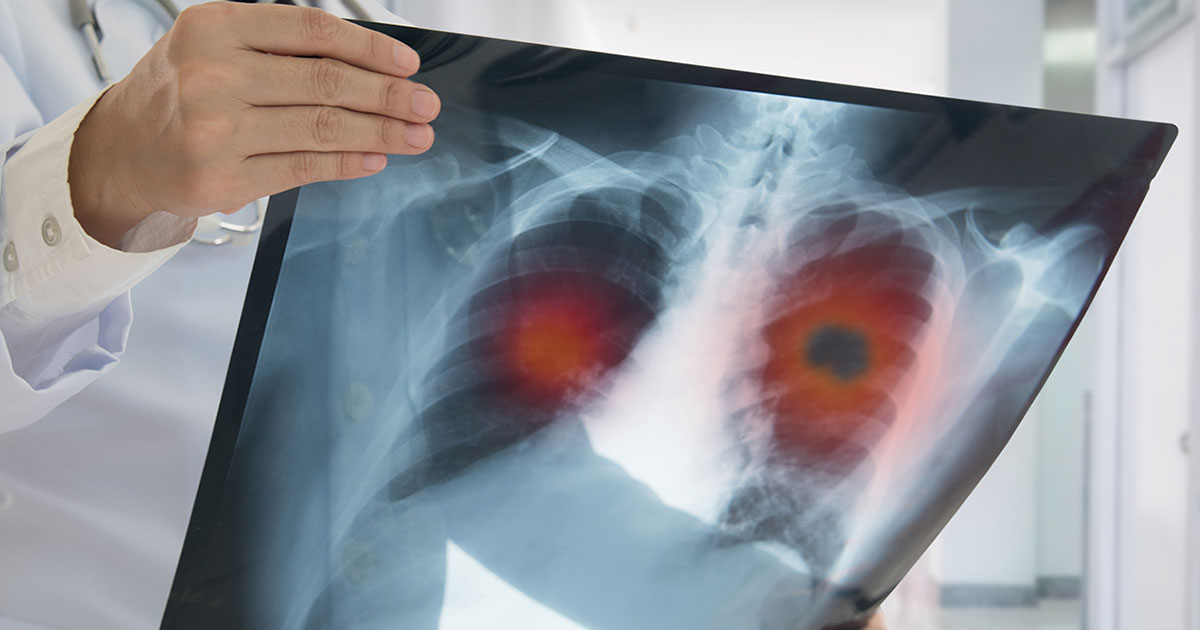
It’s common knowledge that smoking significantly increases the risk of lung cancer. According to the American Cancer Society (ACS), eight out of 10 lung cancer deaths are directly linked to smoking. However, for several decades, scientists have been vexed by a more confounding trend: the increase in the number of lung cancer diagnoses in people who never smoked.
Two studies in 2017—one in the United States and one in the United Kingdom—quantify the increases in lung cancer among non- and never-smokers.
The U.S. study found that 8 percent of more than 12,000 lung cancer patients between 1990 and 1995 were nonsmokers, but the number jumped to nearly 15 percent between 2011 and 2013. The study also found that only adenocarcinoma of the lung, the type most commonly diagnosed in people who have never smoked, had increased.
The U.K. study found an even larger increase in diagnoses among never-smokers—a jump from 13 percent in 2008 to 28 percent in 2014.
Research also indicates that cases of lung cancer in young women who never smoked is rising faster than in young men.
What’s causing these disturbing trends? And what can people who have never smoked do to reduce their risk of lung cancer? In this article, we’ll explore:
- The most common lung cancer in never-smokers
- Possible reasons behind the trends
- Symptoms of lung cancer in never-smokers
- How lung cancer in never-smokers is treated
- Cases that have raised awareness
- Ways to lower risk
- Lung cancer care at Cancer Treatment Centers of America® (CTCA)
If you’ve been diagnosed with lung cancer and would like to learn more about our treatment options at CTCA®, or if you’re interested in a second opinion about your lung cancer diagnosis and treatment plan, call us or chat online with a member of our team.
The most common lung cancer in never-smokers
Lung cancer is the third-most common cancer diagnosed in the United States. It’s also the deadliest cancer in America. In 2021, nearly 132,000 Americans died of lung cancer—22 percent of all cancer deaths.
The two main types of lung cancer are:
SCLC accounts for only about 10 percent to 15 percent of diagnoses and typically occurs in people who smoke. It usually forms in the center of the chest around the bronchi—the passageways that connect the windpipe to the lungs—and grows and spreads quickly.
Most lung cancers—about 80 percent—are NSCLC, which has three sub-types:
- Adenocarcinoma, a slow-growing cancer most commonly diagnosed in nonsmokers
- Large cell carcinoma, which usually grows and spreads at a rapid rate
- Lung squamous cell carcinoma, a cancer most common in smokers
Adenocarcinoma of the lung, which accounts for more than 30 percent of all lung cancers and about half of all NSCLC cases, is the most common lung cancer in the United States. It’s also the most common lung cancer diagnosed in nonsmokers. Notably, more women than men develop adenocarcinoma of the lung, and it occurs more frequently in younger people than other lung cancers.
What is thirdhand smoke and does it increase cancer risk?
Why are never-smokers developing lung cancer?
Many people associate lung cancer with smoking, for good reason: Cigarette smoking remains the single greatest risk factor for the disease. But nearly one in five people who die of lung cancer each year have never smoked.
The truth is many risk factors other than smoking may contribute to an increased lung cancer risk. These include:
Radon: This invisible gas emanates from the ground and may be trapped in homes.
Secondhand smoke: Non-smokers who live with or are often around smokers typically inhale damaging tobacco smoke.
Asbestos: When inhaled, these fibers may cause lung damage. It also causes mesothelioma.
Air pollution: Toxic gases and factory and automobile emissions may increase risk.
Genetics and family history: Never-smokers who have a close family member—a parent, sister or brother, for example—who never smoked and developed the disease before age 50 have a greater risk of lung cancer.
Chronic lung disorders: Lung diseases and infections, such as chronic obstructive pulmonary disorder (COPD), may also play a role.
About 10 percent to 20 percent of lung cancers, or 20,000 to 40,000 a year, are diagnosed in people who have never smoked, according to the U.S. Centers for Disease Control and Prevention (CDC). The CDC estimates that about 7,000 of these cases may be caused by secondhand smoke and 3,000 may be caused by radon.
A 2018 study published in the Journal of Thoracic Oncology concluded that gene mutations commonly found in never-smokers were significantly more prevalent in areas with high radon exposure. And a 2019 study found that features of modern construction in North America—such as increased square footage and higher ceilings—have contributed to an increase in exposure to the colorless, odorless gas.
Learn more about radon exposure and cancer risk
Symptoms of lung cancer in never-smokers
The symptoms of lung cancer are pretty much the same for smokers, non-smokers and never-smokers. Never-smokers may be more likely than smokers to assume their symptoms are caused by a condition other than cancer, possibly delaying a diagnosis until the disease has progressed to a more advanced stage. Symptoms may include:
- A persistent cough that may worsens over time
- Blood in the sputum
- Chest pains
- Difficulty breathing
- Wheezing
- Sore throat, hoarseness, difficulty swallowing
- Unexplained weight loss
- Fatigue
- Recurrent lung infections
Call your doctor if you have these symptoms and they persist.
How lung cancer in never-smokers is treated
In large part, never-smokers with lung cancer are treated the same way as smokers, says Sagun Shrestha, MD, Medical Oncologist and Hematologist at CTCA Phoenix. Common treatments for lung cancer include:
- Surgery
- Immunotherapy
- Chemotherapy
- Radiation therapy
- Targeted therapy
Finding driver mutations
Genomic sequencing looks for genetic mutations in cancer cells. This analysis is especially key in never-smokers because their tumors are often different from those in people who smoke. Never-smokers who develop lung cancer are much more likely to have a targetable driver mutation than smokers. These so-called “driver mutations” are biomarkers that doctors can measure to indicate disease and predict a treatment’s chances of success. Never-smokers have a targetable mutation in 75 percent of cases, compared with 15 percent to 20 percent in smokers.
If doctors can determine a driver mutation caused the cancer, they may be able to recommend targeted therapy, which tends to cause fewer side effects and may have better outcomes.
Because never-smokers are more likely to have driver mutations, they’re more likely to respond to treatment, Dr. Shrestha says. “They’re the ones who are more likely to live longer,” she says.
Their treatment plan may include a smoking cessation program if their spouse or partner smokes, to help prevent secondhand smoke from causing the patient’s lung cancer to come back after treatment.
And it’s important to take a whole-person approach to treating the cancer.
“Treating patients holistically and answering their questions is very important,” Dr. Shrestha says. “So are a team effort and an integrated approach. Nowadays, lung cancer treatment isn’t just biopsy and surgery. It’s genomic testing and sequencing, staging, and meeting with the team to determine the best course of action for treatment.”
Cases that raised awareness
Black Panther actor Chadwick Boseman’s 2020 death from colorectal put a face on the increased numbers of cases in young adults. Because lung cancer cases in both never-smokers and young people have traditionally been relatively rare, only a few high-profile cases have raised awareness of the disease. Among never-smokers who died of lung cancer:
Dana Reeve, the wife of the late actor Christopher Reeve, died of lung cancer in 2006 at age 44. She had a persistent cough, and by the time her cancer was diagnosed, it had already advanced to stage IV.
Dustin Diamond, who played Screech on the TV series Saved by the Bell, died in 2021 of small cell carcinoma just weeks after his diagnosis. He sought treatment after a lump developed in his throat. He was 44.
Joan Scarangello, while not a household name, she served as the inspiration for Joan’s Legacy, a foundation that raises money for lung cancer research. Scarangello, who was a senior writer for Tom Brokaw on NBC Nightly News, died in 2001 at the age of 47. Her mother, also a never-smoker, died 20 years earlier of lung cancer at the age of 50.
Ways to lower risk
Right now, the U.S. Preventive Services Task Force (USPSTF) doesn’t recommend lung cancer screenings for people who have never smoked because the harms, such as radiation exposure and false positives, could outweigh the benefits. The USPSTF recommends a low-dose CT scan for anyone between the ages of 50 and 80 who has smoked at least 20 pack years. A pack year is the equivalent of smoking one pack of cigarettes a day for one year.
Yet there are steps you can take to help lower your risk. They include:
- Getting your home tested for radon and taking steps to lower the level if it’s high
- Limiting your exposure to air pollution, especially if you live in an urban area
- Avoiding secondhand smoke
While these are issues you can control, you have no control over some risk factors, such as a family history of lung cancer. Talk to your doctor about your history and what you can do to mitigate your risk.
You should also avoid vaping and talk to younger loved ones about its potential dangers. “Vaping is rampant, especially among teenagers,” Dr. Shrestha says. “And it’s not safe or regulated by the U.S. Food and Drug Administration.”
Lung cancer treatment at CTCA
At CTCA, we use a wide range of treatments and technologies to treat lung cancer, including chemotherapy, immunotherapy, interventional pulmonology, radiation therapy, surgery and targeted therapy. Your lung cancer treatment team may consist of several doctors, each of whom practices a specific area of medicine. Your team may include a:
- Pulmonologist
- Thoracic surgeon
- Medical oncologist
- Radiation oncologist
These doctors work in collaboration to answer your questions and recommend treatment options based on your specific cancer and individual needs.
If you have been diagnosed with lung cancer, you may also want to consider getting a second opinion. Many patients come to CTCA for a second opinion to get a better understanding of their lung cancer.
Our cancer experts have access to a wide range of diagnostic technology tools and comprehensive treatment options, such as genomic testing, targeted therapy and clinical trials. And our tumor board consists of interdisciplinary experts, including an interventional radiologist, an interventional pulmonologist, a thoracic surgeon, a medical oncologist and a radiation oncologist—all reviewing your CT scans and medical records together.
If you’ve been diagnosed with lung cancer and would like to learn more about our treatment options at CTCA, or if you’re interested in a second opinion about your lung cancer diagnosis and treatment plan, call us or chat online with a member of our team.


